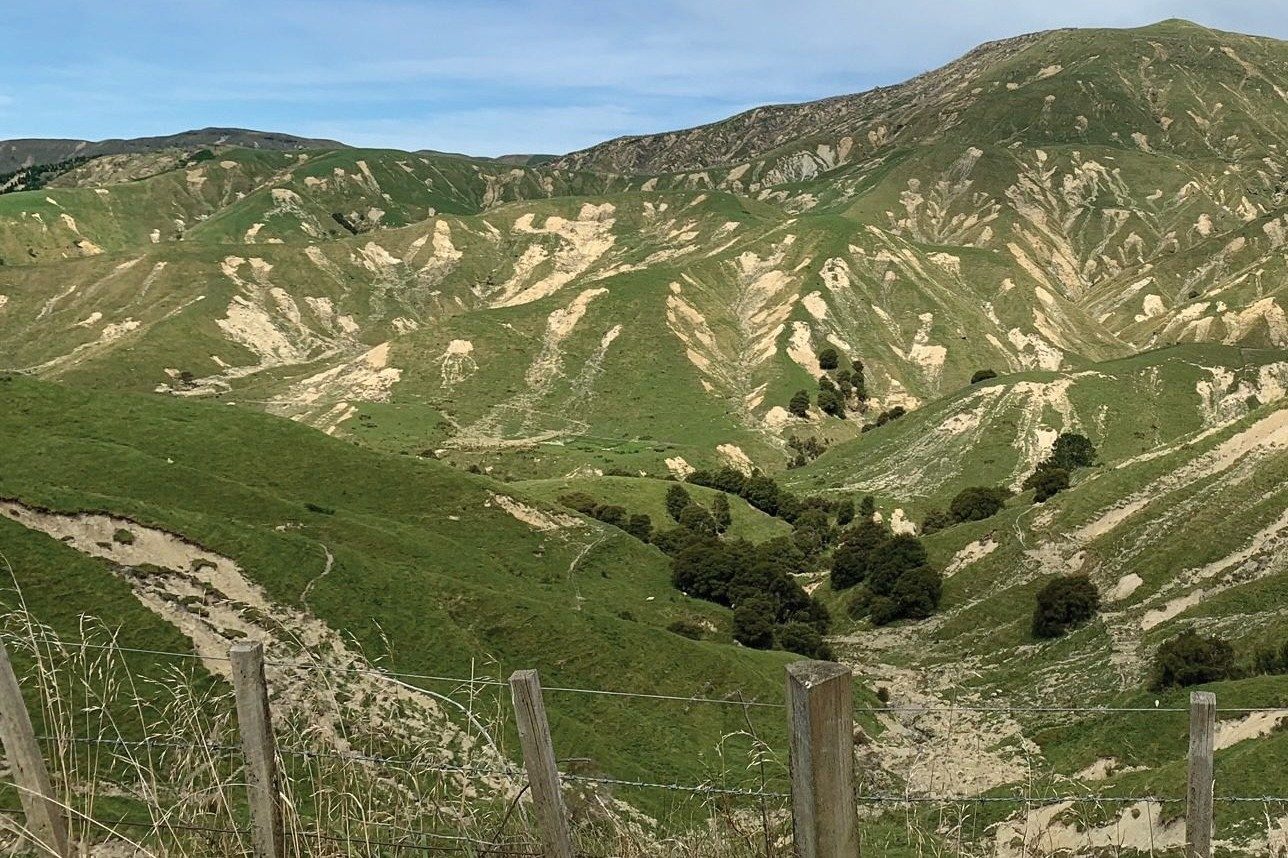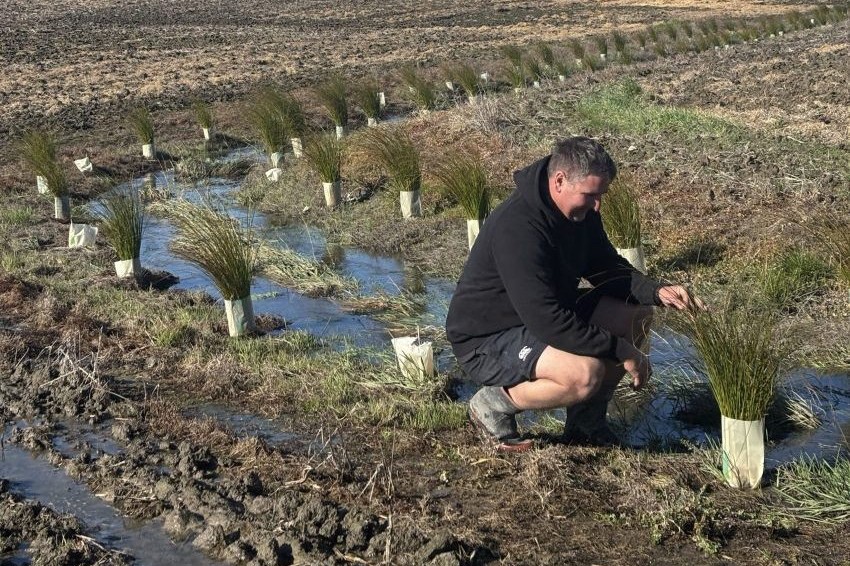Cleaning up after Gabrielle
Country-Wide writers talk to farmers in the path of Cyclone Gabrielle who are still struggling to get stock out and fix fences.
By Claire Ashton

Peter and Judy Gannon, family members and farm owners Graeme and Hamish operate five farms in the Tutira and Mohaka area in northern Hawke’s Bay, with 1600ha total across the farms and about 1420 effective. They run a closed system with 5500 sheep, and 1240 beef, including 400 breeding cows.
“It’s a bit devastating seeing all our work go,” Peter said. “We started farming on our own right after Cyclone Bola and the damage is more significant this time by far.”
For the first two weeks after Cyclone Gabrielle they had no power and only limited access to radio, only RNZ National, with no cell phone coverage. Topdressing pilots dropped generators, fuel, fencing supplies and food in. Cooking was done with gas bottles and open flame barbeques, and they even managed to cook roasts.
Peter was feeling “a bit fragile” after they received 20mm of rain over Easter weekend and says any extra rain just makes the waterlogged ground sloppy. Before the cyclone the land was already wet, about as wet as they usually would be going out of winter.
Three of the farms still can’t get stock out, but Peter was fortunate to get steers out to the works with a 330kg carcaseweight. He suggests their weight was good because the animals were free to roam over much more pasture than usual due to internal fencing losses. Lambs were sent to the works after Easter at 19.8kg CW.
They hadn’t released the rams before the cyclone and needed to get the ewes somewhere they could mob up before they released them. Because of this, breeding patterns will be affected. The Gannon’s were fortunate that their stock loss was minimal – perhaps 40.
Peter’s own farm of 270ha has had 23 slips internally and he’s lost 5.5km of fencing. Most of the external fencing wasn’t too badly affected and has been fixed which was a priority as one of the neighbouring farms had TB.
“It’s amazing the variation of the weather we got from the cyclone. One son is 12km from my home and he had minimal damage, two properties have bad damage, and two farms have severe damage.
“We’ve had this amount of rainfall before without much damage, but the short period of rainfall was intense.”
Fencing loss has been notable. They fixed the internal fencing of about 10-15 posts long to give themselves multiple paddocks as at first there were no stock-proof fences.
Peter says they’ll use electric fencing when they’re doing some fence replacement – either two or three strands. It’s less expensive and easier to repair. The family all pitched in with the fencing repairs, and with the help of a forestry worker, they sheared a large number of sheep using a generator.
Retired land by the river and the riparian planting has been washed away, and silt continues to wash downstream after any rainfall. In essence, that riparian planting added to and became part of the debris.
“In some areas the silt is 12-13ft deep, so you have to be careful working in and around it,” Peter said.
“The areas by the river were flat like a rugby field with the top two inches of posts sticking up. You can walk around on it but there was a guy who got stuck.”
Most help with roading early on came from forestry contractors with trucks and machinery, with expert operators working on clearing roads, but Peter said work seems to have slowed down – after the arrival of road cones and bureaucracy.
“I’m disappointed with the roading progress now. It’s just ground to a halt.
“There were times when you just felt a bit overwhelmed by it all, but you just have to do what you can do. You can’t do it all in one day.”
MATT EVANS HAS been farm manager on Strathblane Station in Hangaroa for the last nine years. The station is divided by the Hangaroa River.
The station’s main side, which was cut off during Cyclone Gabrielle, has 900ha on the steep hill side of the river and 300ha of lower lying land that’s still accessible. It’s a mixed sheep and beef operation, carrying 10,000 stock units made up of 3600 ewes and beef stock, including 400 heifers.
Matt and Jess Evans and their two children heard the heavy rain during the night of the cyclone and Matt didn’t expect to see the bridge in the morning. Their home on a hill escaped flooding, but the bridge connecting them to the world was washed out. Locals believe the water was three metres higher than during Cyclone Bola in 1988.
“As far as slipping goes, it is quite localised – we are in a band that hit half-a-dozen farms real bad, then farms two or three kilometres either side hardly got any slips,” Matt says.
He estimates 30-35% of pasture has been lost to slips on the steeper hill country. Fences have been badly damaged, and they are slowly patching holes up, but more work will occur slowly with a push perhaps over summer if it dries up enough. Of the 27 main paddocks only three remain stock-proof, which means mustering can include trying to cover half the farm. Day-to-day farm life is quite different as it takes so long to muster and get stock to where Matt needs them.
Stock losses, lambs and cows, are certain, but Matt says he couldn’t estimate how many.
“A lot of them will be buried under dirt or washed down the river.”
If some stock has ended up on neighbouring properties, Matt is sure he’ll get them back. They have good neighbours across the river and together they’ve set up a dinghy on ropes to get across.
Due to stock being on the accessible side of the river, Matt was able to send 70 bull beef cattle and 300 lambs to the works, which meant income kept flowing. Normally, this time of year, Strathblane station would have started killing lambs and weaning calves a month ago.
An in-demand digger contractor arrived in the first week of March to work on the new low-level bridge being made from the top of an old bridge, with beams and planks on top for car access, and they can now walk stock out across the river. A priority for the digger is to dig out the buried farm tracks. Once the bridge is in place, they can herd lambs across and get them to the works.
Improvising after Gabrielle
BY GLENYS CHRISTIAN
Grant Hickling estimates he and wife Kerry haven’t fixed 10% of the damage caused by Cyclone Gabrielle on their farm at Rere, 50km inland from Gisborne.
“But we’ll get there,” Grant says.
They winter 5500 stock units, half cattle and half sheep, on 600 hectares with the main damage to the property being to fences and tracks “bowled by slips”.
There were a lot more slips during Cyclone Bola in 1988, but this time around much more material moved.
“There’s 40 sets of floodgates on the farm and a lot were broken or just gone.” Grant says.
Eight dams now filled with soil will need to be dug out.
With many breaks in fences their ewes were shifted to have the run of what had been four paddocks and only one lamb died; the rest of their stock were left to look after themselves on the hill country. The priority was opening up tracks to get around the farm and then to slowly tackle fencing repairs.
“You’ve got to prioritise what’s most important to get done so you can get back to normal as soon as possible,” Grant says.
“If you think about it, you’ll get overwhelmed. The ground is so saturated that it only takes a few millimetres of rain to get everything wet. You’re fighting a losing battle. There’ll be a lot of tidying up in summer.”
While there’s plenty of grass, Grant’s noticed their cattle are very tentative about where they go. “They won’t go onto anything where there’s mud, so they’re difficult to shift,” he says.
“The real nightmare was getting the lambs home to shear. That happened two weeks late because we had no communication.”
To get stock off the farm they ran their lambs down the road and out through a neighbour’s property, something that will need to be repeated.
While the Hicklings’ access road is passable by four-wheel drive vehicles, one load of metal to make it usable to other vehicles can’t arrive soon enough.
“We had a bulldozer and we bought a digger – we’re almost getting around now.”
Ironically, the deal to buy the digger was being done over the phone when the power cut out on the Monday night of Cyclone Gabrielle.
“It was out for a couple of days and we had no landline from Monday until Friday,” Grant says.
Cell phone coverage went as well until Grant got to a paddock called ‘Faraway’ from where the sea can be seen.
“Suddenly I got a lot of messages,” he says. “It’s ridiculous how much we rely on them.”
They hauled out the transistor radio, but the eight batteries they had were all the wrong size. “So we ended up eating toast in the car listening to the radio in there.”
Their house wasn’t damaged, making them very sympathetic to farmers struggling through mud during the day but unable to go back to a warm and clean home.
When Grant poisoned his finger cutting up dog tucker and went into town to the doctor, he was pleasantly surprised to find an appointment wasn’t required.
“Their fridge wasn’t working so I needed to go to the hospital to get a tetanus injection. I went straight into A and E – it was a breeze.”




